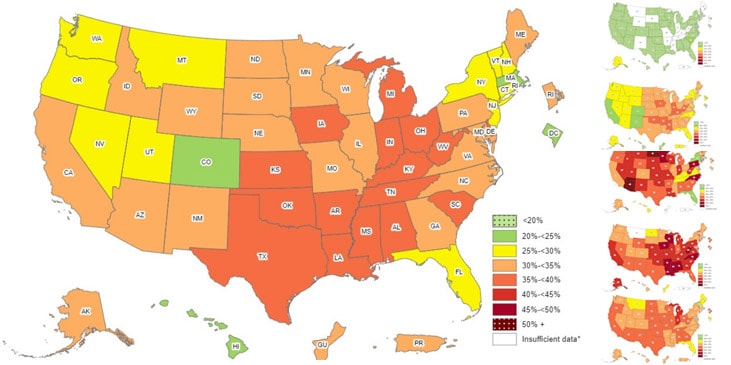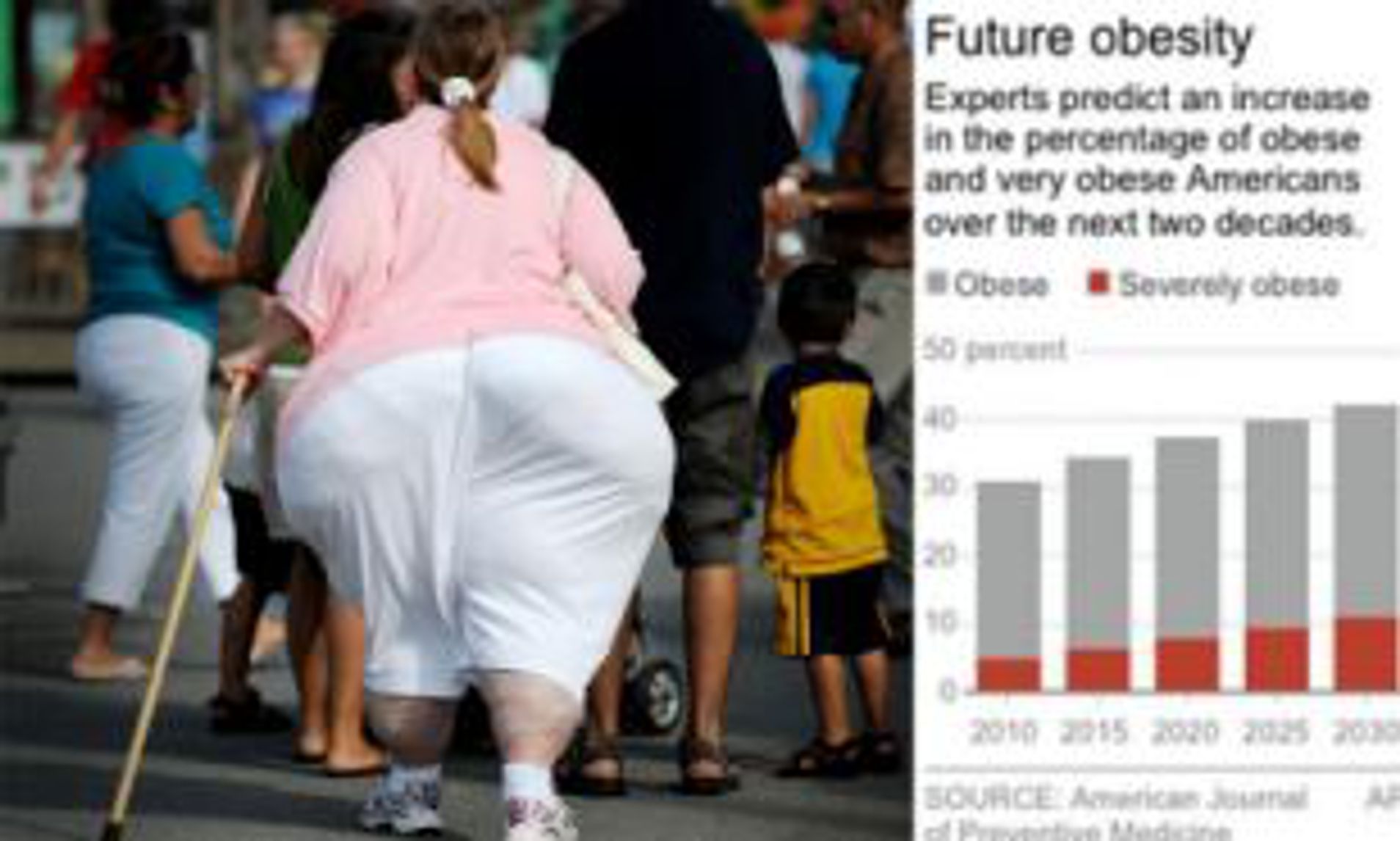Over 70% of American adults are classified as overweight or obese. This staggering statistic reflects a major health concern.
Obesity in America has become a significant public health issue, affecting an alarming number of individuals across various states and communities. With trends indicating a relentless rise in obesity rates, health professionals are calling attention to the need for immediate action.
The figures paint a sobering picture; chronic diseases linked to being overweight, such as diabetes and heart disease, are on an upsurge, further burdening the healthcare system. Efforts to address this issue encompass a range of strategies, from promoting healthier dietary options to encouraging regular physical activity. Understanding the scope of the problem is the first step toward instituting effective public health policies and fostering a societal environment supportive of a healthier lifestyle.

Credit: www.axios.com
The State Of Obesity In America
The obesity landscape in the United States presents a stark reality. A substantial portion of the American population contends with excessive weight, with profound implications for nationwide health, healthcare costs, and quality of life. Diving into current statistics and contributing factors unravels the complexity behind this public health challenge.
Prevalence And Trends
The sheer number of people wrestling with weight issues paints a startling picture. Data reveals that the prevalence of obesity continues to climb, touching all age groups and demographics. Key metrics highlight this growing concern:
- Adult obesity remains high, with significant increases over recent decades.
- Childhood and adolescent obesity also show upward trends, setting the stage for future health complications.
- Obesity disparities among different racial and socioeconomic groups are apparent and important to address.
| Year | Percentage of Adults |
|---|---|
| 1990 | ~12% |
| 2000 | ~23% |
| 2010 | ~34% |
| Current Estimates | approaching 40% |
Factors Influencing Overweight
A labyrinth of elements contributes to the obesity epidemic. Understanding these factors is critical in reversing the trend. They include:
- Dietary habits: High-calorie, low-nutrient foods dominate many Americans’ diets.
- Physical inactivity: Sedentary lifestyles reduce daily calorie burn.
- Socioeconomic factors: Income and education levels influence food choices and access to wellness resources.
- Genetics: Some individuals have a genetic predisposition to weight gain, compounded by environment and behavior.
Environmental factors, such as communities with few places for physical activity, also play a role. Policies aiming to improve the food and physical environments could encourage healthier choices for Americans.
Health Implications Of Being Overweight
Understanding the full spectrum of risks associated with being overweight is vital. These risks go beyond the common physical complications. They also include psychological strains that affect mental well-being. The statistics are startling, as an alarming number of Americans struggle with weight-related issues. Let’s delve into how carrying extra weight impacts one’s life.
Physical Health Risks
Excess weight increases the strain on bodily systems, elevating the risk for numerous diseases:
- Heart Disease: Potential for elevated blood pressure and cholesterol levels.
- Type 2 Diabetes: High likelihood with insulin resistance.
- Cancers: Increased risk for breast, colon, and other cancers.
- Sleep Apnea: Higher incidence in overweight individuals.
- Osteoarthritis: Extra weight adds pressure on joints.
Psychological Impact
The weight of the body can also burden the mind in several ways:
- Self-Esteem: Negative self-image frequently observed.
- Anxiety: Greater levels reported due to societal pressures.
- Depression: High body mass index correlates with depression rates.
- Social Stigma: Overweight individuals can face social discrimination.
- Eating Disorders: Weight concerns may lead to unhealthy eating habits.
Addressing Overweight In America
The American overweight dilemma is a growing concern. With more than two-thirds of US adults carrying extra weight, it’s a national health emergency. Lifestyle choices, dietary habits, and genetics play roles. The fallout? Higher risks of diabetes, heart disease, and numerous other health issues.
Public Health Initiatives
Public Health Initiatives
Public health campaigns offer educational resources on healthy eating and physical activity. They promote the importance of maintaining a balanced diet and regular exercise.
- ‘MyPlate’ program: A visual tool to help Americans eat healthier.
- Farmers’ market incentives: Making fresh produce more affordable.
- School health guidelines: Ensuring access to nutritious school meals.
State and local governments also support exercise-friendly infrastructure, such as parks and bike lanes. These efforts encourage active lifestyles.
| Initiative | Goal | Impact |
|---|---|---|
| Nutrition Education | Improve dietary habits | Increased awareness |
| Exercise Programs | Foster physical activity | Enhanced fitness levels |
| Healthy Schools | Protect children’s health | Reduced childhood obesity |
Individual and Community Efforts
Individual And Community Efforts
Change begins at an individual level. Small daily steps can lead to big health improvements. Joining a local fitness group fosters accountability. Sharing healthy recipes with friends spreads good habits.
- Start a home garden for fresh vegetables.
- Take the stairs instead of the elevator.
- Organize community healthy potlucks.
Community gardens and health workshops unite neighbors. They teach valuable skills for a healthier lifestyle. Everyone can make a difference. Together, we can tackle overweight in America.
Credit: www.cdc.gov
Challenges And Future Outlook
The rise in the number of overweight Americans presents considerable challenges. It affects overall health and increases the risk of numerous diseases. The future outlook hinges on understanding these challenges and implementing effective solutions.
Obstacles To Overcome
A multitude of obstacles stand in the path to reducing the overweight statistics. Lifestyle choices, such as poor diet and lack of exercise, play a significant role. Additionally, economic factors often limit access to healthy food options for many people.
- Limited access to fresh, affordable food
- High-calorie diets and processed foods’
- Sedentary work and home environments
- Genetic predisposition to weight gain
- Lack of public awareness and education
Potential Solutions
Tackling obesity requires a multifaceted approach. Education and awareness campaigns can enlighten the public. Policy changes may improve access to nutritious foods.
- Launch national health campaigns to educate on diet and exercise.
- Subsidize healthy food options to make them more accessible.
- Promote active lifestyles through community programs.
- Implement school-based initiatives to instill good habits early.
- Invest in research for obesity-related healthcare improvements.
Conclusion And Call To Action
The matters of obesity and overweight in America require our immediate attention. This conclusion draws us to recognize the importance and urgency for action. We now know that a substantial number of Americans face health risks due to excess weight. Hence, the final part of this discussion calls for a collective effort to build a healthier nation.
Importance Of Addressing Overweight
It’s clear that overweight is not just a personal issue; it’s a national concern. A greater understanding and response are crucial to prevent chronic diseases linked to being overweight, such as heart disease, diabetes, and stroke.
- Education on healthy lifestyle choices is essential.
- Access to nutritious food should be a priority.
- Community support systems can drive positive change.
Creating A Healthier Future
To create a healthier future, we must take actionable steps. This includes both individual commitments to a healthier lifestyle and policy changes that support public health.
- Encourage regular physical activity in daily routines.
- Support local production of fruits and vegetables.
- Advocate for health education in schools.
A collective effort can lead to impressive results. Together, we can reduce the prevalence of overweight and obesity in America. Let’s commit to these changes for ourselves, our families, and our communities.

Credit: www.cdc.gov
Frequently Asked Questions On How Many Americans Are Overweight
What Percentage Of America Is Overweight?
As of the latest data, around 73. 6% of American adults are considered overweight or obese.
What Percentage Of Americans Are Obese 2023?
As of 2023, approximately 42% of Americans are classified as obese.
Is The Us The Most Overweight Country?
No, the US is not the most overweight country, but it has a high obesity rate.
What Gender Is More Overweight?
Globally, more women are obese than men.
Conclusion
The prevalence of overweight individuals in America is a pressing issue. With proactive measures and informed choices, the trend can be reversed. Initiatives such as healthier diets and regular exercise are key to combating this concern. Let’s support efforts to promote well-being and fight obesity together.
Embracing change can lead to a healthier nation.


